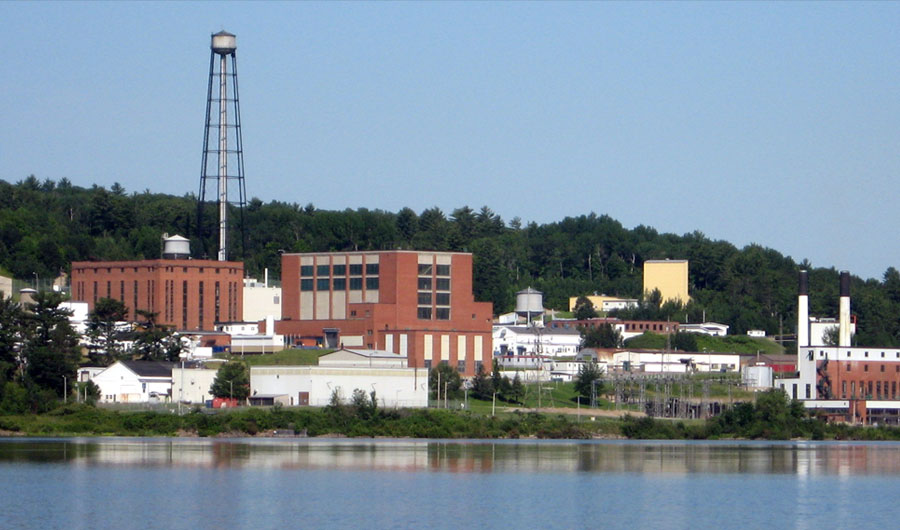Medical Imaging Faces Shortage of Key Radioactive Material

A view of the Chalk River Laboratory, which houses the NRU reactor.
Padraic Ryan via Wikimedia Commons
(Inside Science) -- If a doctor is concerned about a patient's heart health, he or she might order a test to check the blood flow to the heart muscles. Such tests are often performed by injecting a small amount of radioactive material into the blood and tracking its path with cameras that detect radioactive decay. But the closure of a Canadian research reactor for security and financial reasons last month puts at least some of these and similar procedures at risk.
The closure of the National Research Universal (NRU) reactor in Chalk River, Ontario, removes about 19 percent of global production of molybdenum-99, a precursor to the most commonly used medical radioactive tracer, technetium-99m. The reactor’s shutdown, according to a report issued in September by the National Academies of Sciences, Engineering, and Medicine raises the possibility of “severe shortages” that can have a significant impact on medical care.
That’s because the 59-year-old NRU -- the oldest of this type in operation -- is one of only seven research reactors worldwide that produce 95 percent of molybdenum-99 (Mo-99). Those reactors, in turn, rely on just five facilities to process the uranium "targets" that are bombarded with neutrons to make that particular isotope of molybdenum, which has more neutrons than most naturally occurring varieties of the element. None of the reactors or processing facilities are in the United States, even though Americans account for half of the global demand for Mo-99.
“Although there are plans from both existing international suppliers and potential domestic suppliers to fill the expected supply gap from Canada, the committee is concerned that any delays in bringing additional supplies of molybdenum-99 to the market would increase the risks of substantial shortages,” said S. James Adelstein, emeritus professor of medical biophysics at Harvard Medical School in Boston, Massachusetts, and chair of the National Academies’ committee, in a statement.
“It’s a complicated situation,” said Thomas Ruth, senior research scientist (emeritus) at the British Columbia Cancer Research Center in Vancouver, Canada, who was vice-chair of the committee.
“Our concerns were based on the fact that other reactors have had shutdowns over the past five years,” Ruth continued. “So even in the next 18 months there’s the likelihood that one facility will go down.”
The Importance of Radioactive Isotopes in Medicine
Doctors use radioactive isotopes in a range of diagnostic procedures. They are chemically attached to other compounds that accumulate in a target organ. Once there, the isotopes emit radiation that specialized camera equipment picks up. The procedure is fast and, unlike biopsies and surgical procedures, noninvasive. The radiation dose is generally low and does not pose a significant health risk.
Created by the radioactive decay of molybdenum-99, technetium-99m (Tc-99m) is the most popular medical isotope, used in about 80 percent of the imaging procedures that rely on radioactive tracers. It is an unstable form of technetium-99, an isotope of the radioactive element technetium whose nucleus contains 99 protons plus neutrons.
“[Tc-99m] is the optimum radionuclide to use for imaging purposes,” Adelstein said, citing the fact that it is easy to detect with the specialized cameras, and the way it decays means lower doses of radiation for patients.
It’s primarily used for imaging blood flow to diagnose coronary artery disease, Adelstein said.
“That accounts for about 50 percent of examinations with radionuclides in the U.S.,” he added. It is also used for bone and brain scans and identifying certain cancers.
A Complex Supply Chain
Tc-99m has a half-life -- the time it takes for half of it to decay radioactively -- of only six hours once it’s produced. So it can't be shipped over long distances. Instead, most hospitals receive the parent isotope molybdenum-99 and let it decay into Tc-99m on site.
Complicating the situation, Mo-99 itself has a half-life of only 66 hours. That means that it can't be stockpiled.
As a result, the process of transport from reactor to patient is complicated and filled with logistical, security and economic concerns. It’s no surprise that there are so few reactors like the Canadian NRU that make molybdenum-99.
The process starts with the creation of a "target" made from the radioactive isotope uranium-235. An added complication stems from the fact that much of the current production requires highly enriched uranium (HEU). This presents security risks because HEU is also the raw material for nuclear weapons.
The National Academies report points out that several suppliers of Mo-99 are developing targets that contain only low enriched uranium (LEU). Routinely used in commercial nuclear reactors, LEU presents no danger of weaponization. However, many of the new targets are still in the development stage.
The need to eliminate HEU is one of what Ruth describes as “two overriding reasons” for closing down Canada’s NRU reactor. The authorities “won’t convert to LEU,” he explained. In addition, he continued, the reactor was not operating at full cost recovery.” In other words, the costs of running the reactor have become too high for the Canadian government.
Once reactors have the targets, they bombard them with neutrons to produce molybdenum-99. The isotope is shipped to processing facilities that purify it and insert it in devices formally called technetium-99m generators and known as "moly cows."
Those devices, well shielded to prevent the escape of radiation, are transported to hospitals, clinics and other medical facilities. There, the Tc-99m created as the molybdenum isotope decays is removed chemically for use in patients. A typical generator that contains just a few micrograms of Mo-99 can produce enough of the technetium isotope to diagnose 10,000 patients.
The process “has to work pretty quickly; you have to get it done in the same week,” Adelstein explained. “Even if production is down for a couple of weeks you’ve lost two weeks’ supply. So, if one or two suppliers go down you get into trouble.”
The medical community realized the supply chain’s vulnerability in April 2010, Adelstein said, when the eruption of the Eyjafjallajökull volcano in Iceland prevented air travel across Northern Europe for several days, halting transatlantic shipments of Mo-99 from reactors in Canada and Europe.
The closure of the NRU reactor exacerbates the potential for shortages of the isotopes. But in the case of a severe global shortage, the Canadian government has agreed to become “a supplier of last resort” between now and March 2018, when the reactor will close permanently.
That pledge gives less reassurance than the medical community might hope.
“The outage would have to be listed by the Organization for Economic Co-operation and Development as a genuine emergency,” Ruth explained. “And it’s going to be based on having HEU targets available -- a security issue.”
Restarting the NRU would also take time. “Say there’s an emergency tomorrow,” Ruth said. “They’d have to radiate targets for five days to make them useful.”
The Search for Alternative Approaches
Other efforts to overcome potential shortages focus on alternative methods of producing the isotopes.
NorthStar Medical Radioisotopes in Wisconsin is working with the Argonne National Laboratory in Illinois on creating Mo-99 from stable molybdenum isotopes. One of those processes is expected to be ready for action in 2018. A method that produces Mo-99 by bombarding uranium in solution with neutrons, meanwhile, is targeting 2019 for commercial introduction.
However, Ruth questions whether the demand for those technologies will be sufficient to cover their cost. “Even in the best circumstances the profit margin is fairly low,” he said.
In another approach, “the Canadians are looking at making technetium-99 directly, using particle accelerators,” Adelstein said. “But they would need one in every province.”
Diagnosticians could also substitute another isotope -- thallium-201 -- for Tc-99m. “It’s made on an accelerator and measures myocardial blood flow,” Adelstein said. “But it doesn’t have as optimum a photo peak as Tc-99m,” meaning that the images it produces are less clear.
Research efforts also focus on the security issue. As the National Academies’ report notes, “The study recommends that the U.S. government continue to work with global Mo-99 suppliers and their regulators to reduce the proliferation hazard from wastes containing HEU.”
Making sure the medical community gets the radioactive isotopes it needs in a safe and secure way is a challenge that involves more than technological fixes. It’s an international issue that will require scientists, engineers, policy makers and diplomats to all work together.

